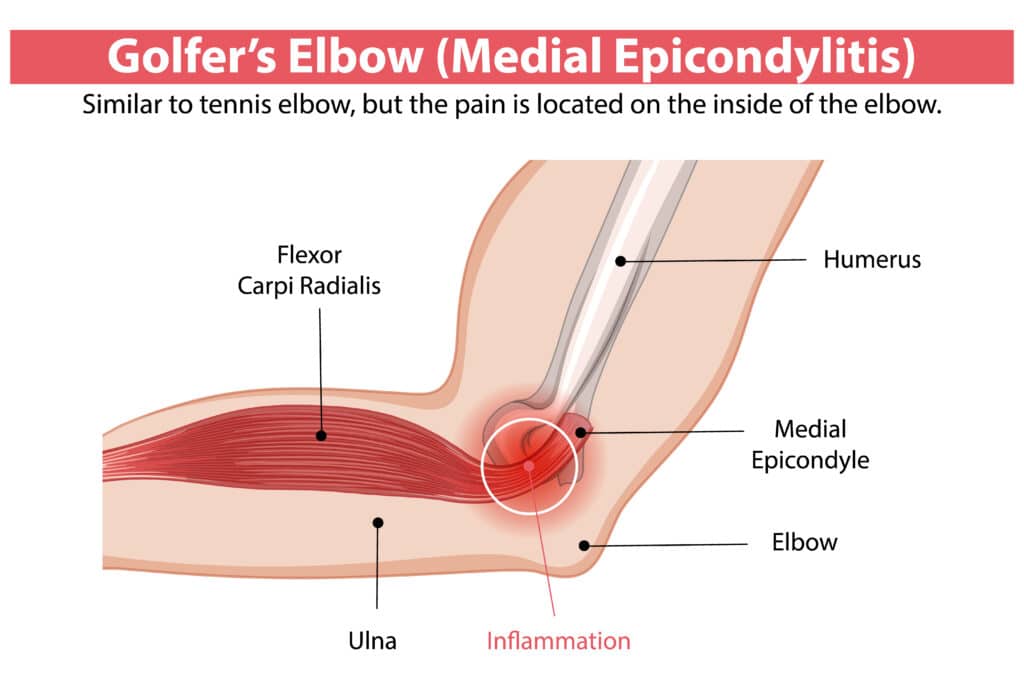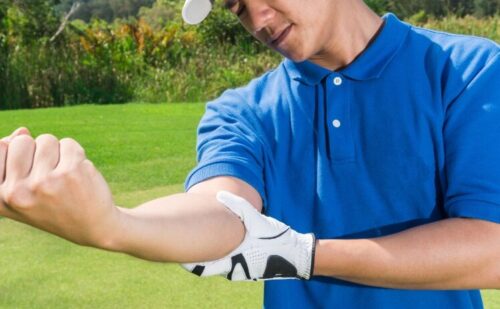Golfer’s elbow, medically known as medial epicondylitis, is a common overuse injury that causes pain on the inner side of the elbow. Despite its name, this condition isn’t limited to golfers—it can affect anyone who engages in repetitive wrist and forearm movements, such as weightlifters, tennis players, and manual labourers. At Essential Health Physiotherapy in Loganholme, we specialise in diagnosing and treating Golfer’s Elbow to help you recover faster and prevent recurrence. Understanding the causes, symptoms, and treatment options is crucial for long-term relief and full recovery.
What Causes Golfer’s Elbow?
Golfer’s elbow occurs when the tendons that attach to the medial epicondyle (the bony bump on the inside of the elbow) become irritated due to repetitive stress. Common causes include:
- Overuse of the Forearm Muscles: Repetitive gripping, lifting, or twisting motions strain the tendons.
- Poor Technique: Incorrect form in sports or manual work can increase stress on the elbow.
- Weak Forearm Muscles: Insufficient strength in the wrist flexors and pronator muscles leads to increased strain.
- Sudden Increase in Activity: A rapid increase in training intensity or workload can overload the tendons.
Symptoms of Golfer’s Elbow

The key signs of golfer’s elbow include:
- Pain and tenderness on the inside of the elbow
- Stiffness and reduced grip strength
- Pain that worsens with gripping, lifting, or bending the wrist
- Tingling or numbness that may extend into the forearm or fingers
Early intervention is key to preventing long-term discomfort and functional limitations.
5 Powerful Ways to Treat and Prevent Golfer’s Elbow
1. Rest and Activity Modification
- Avoid repetitive activities that aggravate the condition.
- Modify techniques in sports and work tasks to reduce strain on the elbow.
2. Strengthening Exercises
- Strengthen the wrist flexors, forearm muscles, and grip to improve resilience.
3. Stretching and Mobility Work
- Stretch the forearm flexors and extensors to improve flexibility and reduce tension.
- Gentle wrist and elbow mobility exercises can promote healing.
4. Pain Management Techniques
- Apply ice packs to the inner elbow to reduce inflammation and discomfort.
- Use a compression brace to offload stress from the affected tendons.
- Nonsteroidal anti-inflammatory drugs (NSAIDs) may be helpful for pain relief.
5. Seek Physiotherapy
- A physiotherapist can assess muscle imbalances and provide targeted exercises.
- Manual therapy, dry needling, and shockwave therapy may aid in recovery.
Preventing Golfer’s Elbow
To minimise the risk of developing golfer’s elbow, follow these preventive strategies from our Physiotherapists in Loganholme:
- Strengthen the Forearm Muscles: Regularly perform wrist and grip strength resistance exercises.
- Stretch Before and After Activity: Maintain flexibility in the forearm and wrist.
- Use Proper Equipment: Choose golf clubs, racquets, and tools that suit your grip and mechanics.
- Gradually Increase Activity Levels: Avoid sudden increases in workload to prevent excessive strain.
- Practice Good Form: Ensure correct technique in sports and occupational tasks to reduce stress on the elbow.
When to Seek Professional Help
If your symptoms persist despite self-care, it’s crucial to seek professional treatment. Our Loganholme physiotherapists can design a personalised rehabilitation plan to address the root cause and prevent recurrence.
Book a Consultation Today
Don’t let golfer’s elbow keep you from your favourite activities! Our expert physiotherapists in Loganholme specialise in musculoskeletal conditions and can help you recover effectively.
Book a consultation today by calling 07 3132 0898, and take the first step toward pain-free movement.
References
Tyler, T. F., Thomas, G. C., Nicholas, S. J., & McHugh, M. P. (2019). Rehabilitation strategies for medial and lateral epicondylitis. Journal of Sports Rehabilitation, 28(2), 159-167. https://doi.org/10.1123/jsr.2018-0032
Check our Previous Blogs


